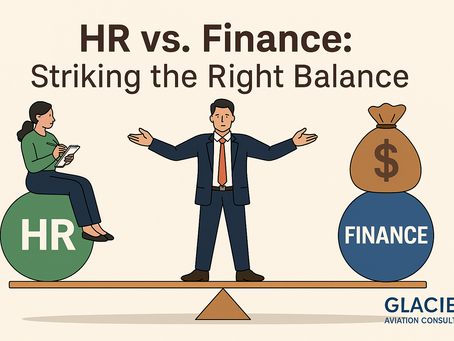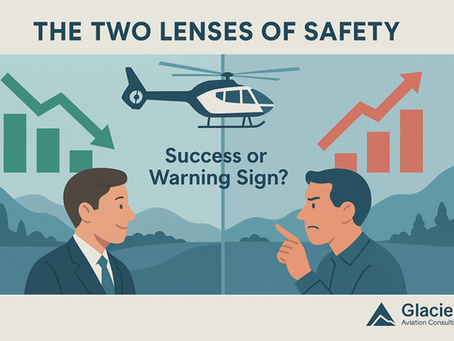top of page
All Posts


Safety Performance Indicators: Measuring What Matters in Aviation Safety
Safety Assurance monitors whether safety controls work as intended. Safety Performance Indicators (SPIs) show how well they work. SPIs turn complex operational data into measurable insight. They make safety performance visible, and that visibility is what allows organizations to make informed, timely decisions. Safety Performance Indicators — the pulse check of your safety system. What Are Safety Performance Indicators? Safety Performance Indicators are measurable metrics u
Margrét Hrefna Pétursdóttir
2 days ago3 min read


Safety Assurance: Monitoring the Health of Your Safety System
In aviation, hazard identification tells us what could go wrong. Safety assurance tells us whether our defenses are working. Safety assurance is the third pillar of the Safety Management System (SMS). It verifies that the organization’s safety processes are functioning as intended, not just on paper, but in daily operations. When done well, it turns safety management from reactive problem-solving into continuous improvement. The Safety Assurance pillar — verifying that your
Margrét Hrefna Pétursdóttir
4 days ago2 min read


Reactive Hazard Identification: Mandatory Occurrence Reporting
Doing What’s Required EU Regulation 376/2014 sets out what must be reported through the Mandatory Occurrence Reporting (MOR) system. Most operators comply, and that’s a good thing. It’s the backbone of reactive hazard identification. When something significant happens, an aircraft system malfunction, a runway incursion, a loss of separation, the MOR process ensures it’s documented, analyzed, and shared across the system. That’s how we learn from what has already happened. B
Margrét Hrefna Pétursdóttir
7 days ago2 min read


Reactive Hazard Identification: Learning from Accidents and Incidents
From Investigation to Understanding When an accident or incident occurs, the investigation that follows often draws attention, but the real value lies in what the organization learns from it. Reactive hazard identification is about using these occurrences to reveal underlying system weaknesses, not to assign blame. By analyzing what went wrong and sharing what was learned, organizations can identify hazards that would otherwise remain hidden, strengthening their defenses lon
Margrét Hrefna Pétursdóttir
Oct 223 min read


Reactive Hazard Identification: Information Sharing
From Concept to Practice in Reactive Hazard Identification Earlier this month, in Learning from What Happened: Reactive Hazard Identification , we explored the concept of reactive hazard identification, understanding events that have already occurred to strengthen future defenses. This week, we move from concept to practice and look at the methods we can use to identify hazards reactively. We begin with information sharing , both within the organization and across the wider
Margrét Hrefna Pétursdóttir
Oct 203 min read


Compliance Audits as Proactive Hazard Identification
In June, I wrote that Compliance Monitoring isn’t about finding Findings . The point was simple: audits are not about catching people...
Margrét Hrefna Pétursdóttir
Oct 172 min read


Proactive Risk Assessments: Why Assess What’s Already Active?
Aviation never stops moving. New routes, new bases, new contracts, everything happens fast. In that environment, proactive risk...
Margrét Hrefna Pétursdóttir
Oct 152 min read


Normal Operations Schemes: Proactive Hazard Identification in Practice
On October 1, I wrote about proactive hazard identification , the methods we use to uncover hazards in daily operations, before they...
Margrét Hrefna Pétursdóttir
Oct 132 min read


Management of Change: A Predictive Tool, Not Just a Checklist
Change in aviation is constant. New contracts, new routes, new technology, new people, nothing stays still for long. But with each change...
Margrét Hrefna Pétursdóttir
Oct 92 min read


Flight Data Monitoring: Predictive Safety in Action
In last week’s articles, we explored the three methods of hazard identification: predictive , proactive , and reactive . Flight Data...
Margrét Hrefna Pétursdóttir
Oct 62 min read


Learning From What Happened: Reactive Hazard Identification
There are three main ways to identify hazards in aviation: Predictive, Proactive, and Reactive . Each has its role, and together they...
Margrét Hrefna Pétursdóttir
Oct 32 min read


Seeing Risks in Real Time: Proactive Hazard Identification
There are three main ways to identify hazards in aviation: Predictive, Proactive, and Reactive . Each has its role, and together they...
Margrét Hrefna Pétursdóttir
Oct 13 min read


Looking Into the Crystal Ball: Predictive Hazard Identification
There are three main ways to identify hazards in aviation: Predictive, Proactive, and Reactive . Each has its role, and together they...
Margrét Hrefna Pétursdóttir
Sep 292 min read


Myth Buster: Just Culture is Only for Frontline Staff
When people hear Just Culture , they often think about pilots, engineers, and ground crew. The idea is that they can report mistakes...
Margrét Hrefna Pétursdóttir
Sep 261 min read


The Real Purpose of a Just Culture Policy
Aviation needed Just Culture because blame was killing safety. For decades, accidents and incidents were followed by finger-pointing. The...
Margrét Hrefna Pétursdóttir
Sep 242 min read


Safety Policy: More Than Just a Tick in the Box
Every operator has a Safety Policy. It is a requirement, after all. But in my experience at Glacier Aviation Consulting, when assisting...
Margrét Hrefna Pétursdóttir
Sep 222 min read


Does Human Resources Matter for Reporting Culture?
When we talk about safety reporting and just culture, our first thought usually goes to the Safety Department or Compliance. Sometimes...
Margrét Hrefna Pétursdóttir
Sep 182 min read


Helicopter Operations: What the Numbers Don’t Tell Us
The EASA Annual Safety Review 2025 paints an interesting picture of helicopter operations in Europe. Fatal accidents are at their lowest...
Margrét Hrefna Pétursdóttir
Sep 102 min read


Runway Excursions is Still the Top Risk: When Fuel Saving Undermines Safety
The 2025 Annual Safety Review, published by EASA on 26 August, once again confirms that runway excursions remain one of the top accident...
Margrét Hrefna Pétursdóttir
Sep 82 min read


Myth Buster: Safety Data Is Just for Regulators
❌ Myth: Safety data is something you collect because the authority requires it. ✅ Reality: Safety data is one of the most valuable...
Margrét Hrefna Pétursdóttir
Sep 52 min read
bottom of page
